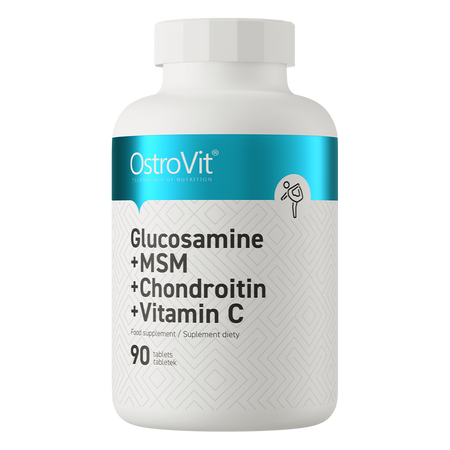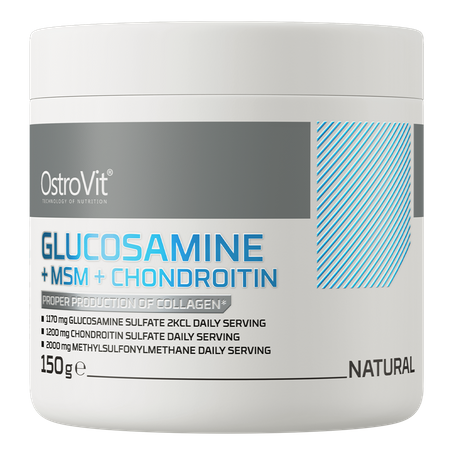Glucosamine
Glucosamine is a compound found in synovial fluid and cartilage. It is a natural substance that has a positive effect on the joints, which makes it widely used in alleviating various diseases and pain associated with them.
Glucosamine - what is it?
Glucosamine is an amino sugar, an organic chemical compound that is an amino derivative of glucose. It is a substance naturally produced in the human body. It is formed from a glucose and glutamine molecule with the participation of an enzyme known as glucosamine synthetase.
Glucosamine has a simple molecular structure and is a substrate for the biosynthesis of proteoglycans, i.e. substances that build joint cartilage.
It is synthesized in the body in small amounts and the ability to produce it decreases with age.
Glucosamine is available in the form of dietary supplements to support joints. Then it occurs in the form of glucosamine sulphate or as glucosamine hydrochloride.
Sources of glucosamine
Glucosamine is produced naturally by the human body. Its source is also seafood, and more specifically shellfish such as:
- crabs,
- crampons,
- shrimps,
- clams.
How does glucosamine work in the human body
Glucosamine is a precursor of the synthesis of glycosaminoglycans, which are responsible for repairing damaged cartilage and maintaining the proper structure of blood vessels. What's more, the compound stimulates collagen synthesis.
Glucosamine has a significant effect on the formation of cartilage and synovial fluid. Therefore, the most widely discussed issue by scientists is its impact on the condition of joints.
The substance may reduce the activity of some enzymes that are involved in the degradation of articular cartilage. In addition, it can be used by chondrocytes, i.e. cartilage cells, to synthesize the previously mentioned glycosaminoglycans. In addition, it has anti-inflammatory properties, inhibiting the synthesis of pro-inflammatory factors such as m.in prostaglandins (PGE2).
Some scientific data suggests that glucosamine may have a beneficial effect on the joints in the case of knee osteoarthritis, and may also reduce pain in the case of osteoarthritis. The results of the research also indicate a possible alleviating effect on ailments associated with knee overload, e.g. due to excessive physical activity.
Which form of glucosamine is best?
Glucosamine in dietary supplements is most often found in two forms, namely as glucosamine sulfate or in the form of glucosamine hydrochloride.
Both forms work similarly and are involved in the synthesis of proteoglycans - substances that build articular cartilage. So both strengthen the joints and support their regeneration.
Despite this, it can be considered that glucosamine sulphate is a better form of the compound, because it is distinguished by a much higher bioavailability, which reaches almost 90%. Thus, most of the substances delivered to the body can be used by it. It is also interesting that glucosamine sulfate does not interact with other drugs, which is extremely important when taking glucosamine during various types of diseases.
Glucosamine in dietary supplements
There are various preparations containing glucosamine available on the market. Some of them are single-ingredient products, others have several complementary compounds.
Dietary supplements with glucosamine often contain the addition of hyaluronic acid, which is an essential part of the synovial fluid. This compound protects the acetabulum against excessive friction and ensures proper cushioning of the joints. Increased friction in the acetabulum results in pain.
In preparations rich in glucosamine, you can also find collagen, which is synthesized by glucosamine. It is the basic building block of cartilage, ligaments and tendons. Collagen enables adequate mobility of the bone joints.
The dietary supplement often also contains chondroitins responsible for nourishing the articular cartilage, which also provide tissue elasticity, and thus can reduce joint stiffness.
All these substances enhance the effect of glucosamine and thus ensure better results of the supplementation used.
Who should consider glucosamine supplementation?
Glucosamine supports joint health. Therefore, it can be recommended among people who are exposed to overload and joint loads, suffer from rheumatic diseases or struggle with degenerative diseases.
In addition, the use of glucosamine is recommended for the elderly who want to strengthen the joints, as well as athletes, with joint diseases and prophylactically to prevent injury.
Proper glucosamine supplementation
Always dietary supplements rich in glucosamine should be taken in accordance with the manufacturer's instructions placed on the product packaging or according to the doctor's recommendation.
The selection of the appropriate portion of the preparation is an individual matter and depends on the patient's needs.
The most commonly recommended dose of glucosamine is 1500 mg and is divided into three portions of 500 mg during the day.
Preparations with glucosamine should be washed down with plenty of water, because this compound is well soluble in it. Thanks to water, glucosamine is better absorbed and its dissolution in the body is accelerated.
To observe the positive effect of the supplement, it is recommended to take the preparation for a minimum of two months.
Side effects and contraindications to the use of glucosamine
Glucosamine, as a naturally occurring substance in the human body, is considered safe. Despite this, do not exceed the recommended portions of dietary supplements rich in this compound.
In extreme cases, the substance may contribute to the occurrence of gastrointestinal symptoms such as nausea, bloating, abdominal pain or diarrhea.
There are also some contraindications to the use of the preparation.
Glucosamine derived from crustaceans, i.e. produced from the carapaces of marine organisms, should not be used among people allergic to seafood, as it may contribute to the occurrence of undesirable symptoms such as erythema, itching of the skin or shortness of breath.
In addition, caution should be exercised among diabetics. Glucosamine is a derivative of glucose, so it can cause fluctuations in sugar levels and increase the concentration of insulin in the blood.
Glucosamine must also not be combined with anticoagulants, as this may contribute to excessive reduction of blood clotting.


 New
New


